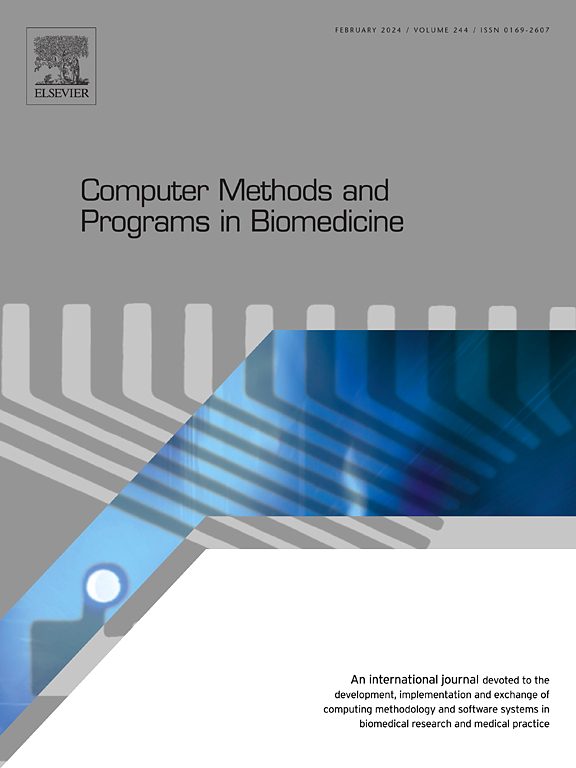基于广义退化的对抗学习的无监督超分辨率内窥镜图像
IF 4.8
2区 医学
Q1 COMPUTER SCIENCE, INTERDISCIPLINARY APPLICATIONS
引用次数: 0
摘要
背景与目的:近年来,基于探针的共聚焦激光显微内镜(pCLE)已成为一种新兴的原位成像和诊断的光学活检方法,有助于炎症、癌症等疾病的准确早期诊断。然而,由于用于信号采集的光纤束的物理限制,获得高分辨率的pCLE图像是具有挑战性的。因此,在本研究中,我们的目标是通过实施先进的后处理技术来提高pCLE图像质量。方法:本文提出了一种无监督的单图像超分辨率框架,该框架不使用高分辨率的pCLE图像作为参考,显著提高了图像质量。该框架由降级模块、样式转换模块和超分辨率模块组成。在退化模块中,我们提出了一个创新的分布假设模块来随机化光纤的位置分布,使我们能够模拟pCLE的成像原理,并创建合成的pCLE图像进行训练。结果:与最先进的方法相比,通过模块集成,定量和定性分析都突出了我们的超分辨率图像管道的显着效率。该框架具有较强的泛化能力,有效缓解了pCLE系统固有特性对图像超分辨率的影响。这个特性特别有利,因为它允许框架在应用于各种设备时规避冗余训练。结论:我们提出的方法具有出色的超分辨率和泛化能力,可以更清晰地观察图像细节,更准确地定位微观结构,有助于精确识别病变区域,提高诊断准确性。本文章由计算机程序翻译,如有差异,请以英文原文为准。
Generalized degradation-based adversarial learning for unsupervised super-resolution of endomicroscopy images
Background and Objective:
In recent years, probe-based confocal laser endomicroscopy (pCLE) has become an emerging optical biopsy method for in situ imaging and diagnosis, which aids in the accurate early diagnosis of diseases like inflammation and cancer. However, due to physical constraints induced by the fiber bundle used for signal acquisition, obtaining pCLE images of high resolution is challenging. Consequently, in this study, we aim to improve pCLE image quality through the implementation of advanced post-processing techniques.
Methods:
Here we propose an unsupervised single image super-resolution framework, which is free of using high-resolution pCLE images as reference and improves image quality significantly. The framework consists of a degradation module, a style transformation module and a super resolution module. In the degradation module, we propose an innovative distribution assumption module to randomize the fiber optic position distribution, enabling us to simulate the imaging principles of pCLE and create synthetic pCLE images for training.
Results:
With the integration of modules, both quantitative and qualitative analyses highlight the remarkable efficiency of our pipeline in super-resolving images compared to state-of-the-art methods. Our framework also demonstrates strong generalization capability, effectively mitigating the impact of pCLE system’s intrinsic characteristics on image super-resolution. This feature is particularly advantageous as it allows the framework to circumvent redundant training when applied to various devices.
Conclusions:
With the outstanding super-resolution and generalization capability, our proposed methodology enables clearer observation of image details and more accurate localization of micro structures, which contributes to precise identification of lesion areas and diagnostic accuracy enhancement.
求助全文
通过发布文献求助,成功后即可免费获取论文全文。
去求助
来源期刊

Computer methods and programs in biomedicine
工程技术-工程:生物医学
CiteScore
12.30
自引率
6.60%
发文量
601
审稿时长
135 days
期刊介绍:
To encourage the development of formal computing methods, and their application in biomedical research and medical practice, by illustration of fundamental principles in biomedical informatics research; to stimulate basic research into application software design; to report the state of research of biomedical information processing projects; to report new computer methodologies applied in biomedical areas; the eventual distribution of demonstrable software to avoid duplication of effort; to provide a forum for discussion and improvement of existing software; to optimize contact between national organizations and regional user groups by promoting an international exchange of information on formal methods, standards and software in biomedicine.
Computer Methods and Programs in Biomedicine covers computing methodology and software systems derived from computing science for implementation in all aspects of biomedical research and medical practice. It is designed to serve: biochemists; biologists; geneticists; immunologists; neuroscientists; pharmacologists; toxicologists; clinicians; epidemiologists; psychiatrists; psychologists; cardiologists; chemists; (radio)physicists; computer scientists; programmers and systems analysts; biomedical, clinical, electrical and other engineers; teachers of medical informatics and users of educational software.
 求助内容:
求助内容: 应助结果提醒方式:
应助结果提醒方式:


